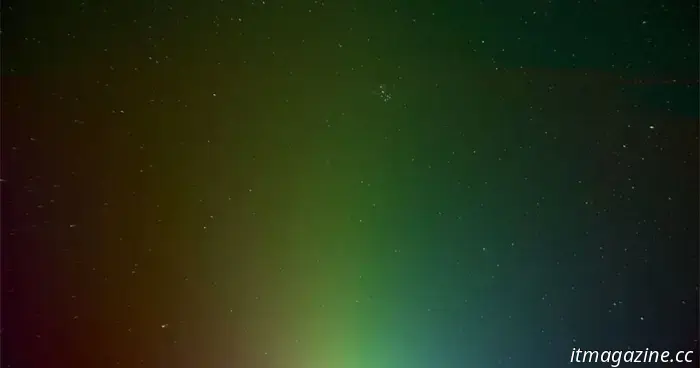
A new NASA mission captures a stunning cosmic rainbow.
On April 18, 2025, the WFI-2 instrument, which recorded its first light on April 14, successfully acquired images using all three of its polarizers in succession for the first time, resulting in this visual. The image has been colorized to illustrate the polarization (or angle) of the zodiacal light, a subtle illumination from dust that orbits the Sun.
A new NASA mission is currently gathering data and generating impressive images of the solar system. Launched in March, the PUNCH (Polarimeter to Unify the Corona and Heliosphere) mission is set to investigate the sun's corona and its interactions with the larger solar system environment. Comprising four small satellites, each about the size of a suitcase, the mission can provide a continuous view of the entire inner solar system because of the cameras mounted on each satellite.
However, before PUNCH can commence scientific operations, its instruments must be activated. During this activation phase, PUNCH’s Wide Field Imager 2 captured an image of the zodiacal light emanating from the sun. This faint glow, commonly observed before dawn and referred to as false dawn, occurs due to sunlight scattering off the dust floating in the solar system.
In the complete image displayed below, a spectrum of zodiacal light is visible, with the sun's position indicated by a star. The image employs color to distinguish light features: the color indicates the direction of the light, while the saturation level signifies the polarization degree. Additionally, background stars appear in white, including the Pleiades star cluster above the center of the image and the V-shaped Hyades star cluster positioned toward the upper left.
On April 18, 2025, the WFI-2 instrument, which had its first light on April 14, used all three of its polarizers in sequence for the first time, producing this view. The image is colorized to represent the polarization (or angle) of the zodiacal light, a soft glow resulting from dust orbiting the Sun.
Other instruments aboard PUNCH also gathered initial data, including one that captured a remarkable view of the moon. This image was taken by the Narrow Field Imager (NFI), a type of coronagraph that utilizes a dark disk to block sunlight, allowing fainter objects, such as the moon, to be visible.
During the commissioning phase, PUNCH’s NFI instrument captured this image of the new Moon as it traversed near the Sun in the sky on April 27, 2025.
The NFI will be employed to observe the sun's corona, and the objective of this image was to determine if the moon would obstruct the view. Fortunately, the moon’s brightness is not intense enough to interfere with the scientific data being collected.
PUNCH will proceed with data collection, with two additional instruments set to be commissioned in the coming weeks before full scientific operations commence in June.
Georgina has been a space writer at Digital Trends for six years, covering topics related to human space exploration and planetary science.
NASA has released the first close-up images of the Donaldjohanson asteroid, obtained by its Lucy spacecraft during a recent flyby approximately 139 million miles (223 million km) from Earth.
Following a seven-month residency on the International Space Station (ISS), NASA astronaut Don Pettit and two Russian cosmonauts safely landed in Kazakhstan aboard a Soyuz spacecraft on Sunday, coinciding with Pettit’s 70th birthday. The American astronaut departed from the ISS on Friday alongside Aleksey Ovchinin and Ivan Vagner.
Photographer Don Pettit is nearing his return to Earth after a seven-month mission aboard the International Space Station (ISS). Throughout his time, approximately 250 miles above Earth, Pettit has shared stunning photos and videos capturing Earth and its surroundings, featuring various subjects, including star trails, auroras, rocket launches, and urban landscapes.







Other articles
 Helldivers 2 now allows players to personalize their preferred weapons.
The latest update for Helldivers 2 introduces customization options, additional enemies, and increased chaos.
Helldivers 2 now allows players to personalize their preferred weapons.
The latest update for Helldivers 2 introduces customization options, additional enemies, and increased chaos.
 Marvel 1943: Rise of Hydra follows GTA 6's example and shifts its release to 2026.
According to a post on social media from the development team, Marvel 1943: Rise of Hydra has been postponed.
Marvel 1943: Rise of Hydra follows GTA 6's example and shifts its release to 2026.
According to a post on social media from the development team, Marvel 1943: Rise of Hydra has been postponed.
 The Samsung Galaxy S26 Edge is already being suggested to take the place of an important counterpart next year.
It’s possible that there won’t be a Samsung Galaxy S26 Plus model next year. Instead, we may see this alternative.
The Samsung Galaxy S26 Edge is already being suggested to take the place of an important counterpart next year.
It’s possible that there won’t be a Samsung Galaxy S26 Plus model next year. Instead, we may see this alternative.
 Google's new Android features will safeguard you against a broader array of scams.
Google has developed a range of new scam protection features in Android for identity verification, alerts for screen sharing, and protections against prize and toll scams.
Google's new Android features will safeguard you against a broader array of scams.
Google has developed a range of new scam protection features in Android for identity verification, alerts for screen sharing, and protections against prize and toll scams.
 How to participate in the FBC: Firebreak closed beta test
FBC: Firebreak will be released very soon for all consoles and PC, but Remedy is offering you a chance to get an early look inside the Oldest House. Here’s how you can do that.
How to participate in the FBC: Firebreak closed beta test
FBC: Firebreak will be released very soon for all consoles and PC, but Remedy is offering you a chance to get an early look inside the Oldest House. Here’s how you can do that.
 Nothing and Kef are collaborating to create high-quality audio products.
The technology brand Nothing has revealed a collaboration with Kef, and efforts are already in progress for a new line of products.
Nothing and Kef are collaborating to create high-quality audio products.
The technology brand Nothing has revealed a collaboration with Kef, and efforts are already in progress for a new line of products.
A new NASA mission captures a stunning cosmic rainbow.
A recently initiated NASA mission, PUNCH, has captured its first rainbow image.
